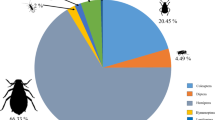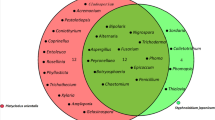Abstract
Two individual, dicotyledoneous leaves (125 and 98 cm2 in size) and one composed palm leaf (c. 6800 cm2 in size), gathered at La Selva Biological Station, Costa Rica, and Jatun Satcha Biological Station, Amazonian Ecuador, were screened for small-scale foliicolous lichen diversity. On the dicotyledoneous leaf from Costa Rica, 49 lichens and one lichenicolous fungus were found, while a comparable leaf from Ecuador revealed 46 lichens and two lichenicolous fungi. The palm leaf yielded 81 lichens and one lichenicolous fungus. This is the highest alpha-diversity so far reported for foliicolous lichens on individual leaves and invites for comparison with tree diversity in tropical rain forests. Due to the high proportion of species represented by a single thallus, the taxonomic diversity of lichens on individual leaves (or trees in selected plots) cannot be self-supporting, but reflects a high degree of dispersion or entropy within the community of which the individual leaf (or selected plot) is part. Diversity is therefore fractal, showing similar patterns at different scales, each part of a given community reflecting the entire community. Thus, mechanisms that result in high small-scale diversity must be looked for at the community level.
Similar content being viewed by others
References
Anderson MC (1964) Light relations of terrestrial plant communities. Biol. Rev. 39: 425–486
Aptroot A (1997) Species diversity in tropical rainforest ascomycetes: lichenized versus non-lichenized; foliicolous versus corticolous. Abstr. Bot. 21: 37–44
Armstrong RA (1989) Competition, seed predation, and species coexistence. J. Theor. Biol. 141: 191–196
Becker P, Lee LW, Rothman ED and Hamilton WD (1985) Seed predation and the coexistence of tree species: Hubbells models revisited. Oikos 44: 382–390
Burkey TV (1994) Tropical tree diversity: a test of the Janzen-Connell model. Oecologia 97: 533–540
Farkas EÉ and Sipman HJM (1997) Checklist of foliicolous lichenized fungi. Abstr. Bot. 21: 173–206
Gentry A (1988) Tree species richness of upper Amazonian forest. Proc. Natl. Acad. Sci. USA 85: 156–159
Gentry A (ed) (1990) Four Neotropical Rainforests. Yale University Press, New Haven, Connecticut
Gradstein SR (1992) The vanishing tropical rain forest as an environment for bryophytes and lichens. In: Bates JW and Farmer AM (eds) Bryophytes and Lichens in a Changing Environment, pp 234–258. Clarendon Press, Oxford
Harling G (1979) The vegetation types of Ecuador, a brief survey. In: Larsen K and Holm-Nielsen LB (eds) Tropical Botany, pp 165–174. Academic Press, London
Hubbell SP, Foster RB, O'Brien ST, Harms KE, Condit R, Wechsler B, Wright SJ and Loo de Lao S (1999) Light-gap disturbances, recruitment limitation, and tree diversity in a neotropical forest. Science 283: 554–557
Janzen DH (1970) Herbivores and the number of tree species in tropical forests. Am. Nat. 104: 501–528
Komposch H and Hafellner J (1998) Biodiversity and ecology of lichens in an Amazonian tropical lowland rain forest. Selbyana 19: 284
Leigh EG Jr., Wright J, Herre EA and Putz FE (1993) The decline of tree diversity on newly isolated tropical islands: a test of a null hypothesis and some implications. Evol. Ecol. 7: 76–102
Lücking R (1995) Biodiversity and conservation of foliicolous lichens in Costa Rica. Mitteil. Eidgenöss. Forsch. anstalt Wald Schnee Landsch. 70: 63–92
Lücking A (1997a) Diversity and distribution of epiphyllous bryophytes in a tropical rainforest in Costa Rica. Abstr. Bot. 21: 79–87
Lücking R (1997b) The use of foliicolous lichens as bioindicators in the tropics, with special reference to the microclimate. Abstr. Bot. 21: 99–116
Lücking R (1998a) Ecology of foliicolous lichens at the Botarrama trail (Costa Rica), a neotropical rain forest site. II. Patterns of diversity and area cover and their dependence on microclimate and phorophyte species. Ecotropica 4: 1–24
Lücking R (1998b) Ecology of foliicolous lichens at the Botarrama trail (Costa Rica), a neotropical rain forest. III. Phorophyte ranges and patterns of phorophyte preferences. Phyton (Horn, Austria) 38: 195–219
Lücking R (1999a) Líquenes foliícolas de la Estación Biológica La Selva, Costa Rica: inventario, comunidades y comparación florística de tipos de vegetación. Rev. Biol. Trop. 47: 287–308
Lücking R (1999b) Ecology of foliicolous lichens at the Botarrama trail (Costa Rica), a neotropical rain forest. I. Species composition and its ecogeographical implications. Biotropica 31: 553–564
Lücking R (1999c) Foliicolous lichens and their lichenicolous fungi from Ecuador, with a comparison of lowland and montane raon forest. Willdenowia 29: 299–335
Lücking R (1999d) Ecology of foliicolous lichens at the Botarrama trail (Costa Rica), a neotropical rain forest. IV. Species associations, their salient features, and their dependence on environmental variables. Lichenologist 31: 269–289
Lücking R (2000a) Lichens on leaves in tropical rain forests: life in a permanently ephemerous environment. In: Gottsberger G and Liede S (eds) Life Forms and Strategies in Tropical Forests. Gebr. Borntraeger, Stuttgart, Germany (in press)
Lücking R (2000b) List of environmental index values for foliicolous lichens. [http://www.unibayreuth. de/departments/planta2/ ass/robert/lichens/listindi.html]
Lücking R and Bernecker-Lücking A (2000) Lichen feeders and lichenicolous fungi: do they affect dispersal and diversity in tropical foliicolous lichen communities? Ecotropica 6: 23–41
Lücking R and Vězda A (1998) Taxonomic studies in foliicolous species of the genus Porina (lichenized Ascomycotina: Trichotheliaceae)-II. The Porina epiphylla group. Willdenowia 28: 181–225
Lücking R, Farkas EÉ, Sérusiaux E and Sipman HJM (2000) Checklist of foliicolous lichens and their lichenicolous fungi. Part I. Foliicolous lichens. [http://www.uni-bayreuth.de/departments/planta2/ ass/robert/lichens/checkfol.html]
McDade LA, Bawa KS, Hespenheide HA and Hartshorn GS (eds) (1994) La Selva. University of Chicago Press, Chicago
Montfoort D and Ek R (1990) Vertical distribution and ecology of epiphytic bryophytes and lichens in a lowland rain forest of French Guiana. MSc Thesis, University of Utrecht, Utrecht, The Netherlands
Sheil D (1999) Tropical forest diversity, environmental change and species augmentation: after the intermediate disturbance hypothesis. J. Veg. Sci. 10: 851–860
Shmida A and Wilson EO (1985) Biological determinants of species diversity. J. Biogeogr. 12: 1–20
Schupp EW (1992) The Janzen-Connell model for tropical tree diversity: population implications and the importance of spatial scale. Am. Nat. 140: 526–530
Sipman HJM (1997) Observations on the foliicolous lichen and bryophyte flora in the canopy of a semideciduous tropical forest. Abstr. Bot. 21: 153–161
Spichinger R, Loizeau PA, Latour G and Barriera G (1996) Tree species richness of a South-Western Amazonian forest (Jenaro Herrera, Peru, 73 degrees 40 minutes W/4 degrees 54 minutes S). Candollea 51: 559–577
Valencia R, Balslev H and Paz y Miño G (1994) High tree alpha-diversity in Amazonian Ecuador. Biodiversity and Conservation 3: 21–28
Author information
Authors and Affiliations
Rights and permissions
About this article
Cite this article
Lücking, R., Matzer, M. High foliicolous lichen alpha-diversity on individual leaves in Costa Rica and Amazonian Ecuador. Biodiversity and Conservation 10, 2139–2152 (2001). https://doi.org/10.1023/A:1013184623641
Issue Date:
DOI: https://doi.org/10.1023/A:1013184623641




